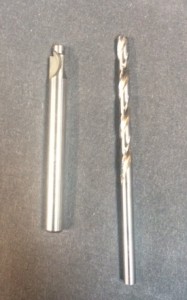
Many custom rifles are offered with upgraded 8-40 scope base screws. These larger fasteners offer increased strength over the standard 6-48 screws found on most factory rifles.
Reasons for upgrading to 8-40 screws include:
- preventing breakage during rough handling
- replacing a stripped 6-48 screw
- aligning the scope screw holes on an action (in some Remington 700 rifles these holes can be misaligned, incorrectly spaced or off center)
- increasing strength for larger cartridges
The Marine Corps uses or has used 8-40 scope base screws on the M40A1, M40A3 and M40A5- which is enough reason for me (jarhead).
In this post, I will be upgrading the scope base on a Remington 700 short-action receiver, however, this process would be similar for most bolt-action rifles. I’ll be working on a milling machine but it isn’t required. A carbide end mill is used instead of a drill bit to allow the realignment of holes.
For most applications, a drill press and vise would provide satisfactory results by simply chasing the factory hole. Please note a drill and drill press will only keep the hole location the same and will not allow realignment. If your holes are in the proper location, Brownells offers a simple Tactical Scope Base Conversion kit with the necessary tools.
I ordered the following items from Brownells:
- Remington 700 short-action receiver (747-000-818)
- 8-40 tap (748-001-840)
- Tap paste (100-015-191)
- Tap guide (100-004-428)
- #8 Counter bore (080-671-841)
- Torx screw assortment (080-924-000)
- Tap handle (395-311-001)
The contents of Rifleshooter.com are produced for informational purposes only and should be performed by competent gunsmiths only. Rifleshooter.com and its authors, do not assume any responsibility, directly or indirectly for the safety of the readers attempting to follow any instructions or perform any of the tasks shown, or the use or misuse of any information contained herein, on this website.
The action must be completely stripped for this operation. The barrel must be removed.






The proper tap drill size for an 8-40 screw is a #28 drill (.1405″). Try finding finding one of those in a short solid carbide end mill. I used a 9/64″ (.1406″) end mill which is readily available and only .0001″ larger than the recommended tap drill size.
For this action, holes will be centered .190″, 1.050″, 4.700″ and 5.300″ from the front edge of the receiver. Blueprints of long and short-action Remington 700 receivers are available online.









If you liked this post, check out Project Guns- Gunsmithing articles and posts, or subscribe to this blog (top right corner of page).




You must be logged in to post a comment.